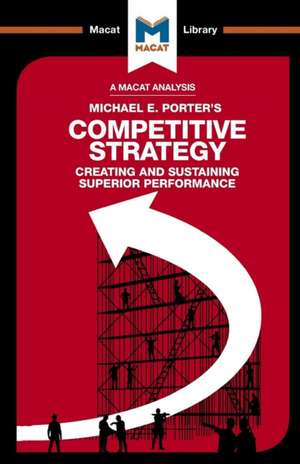An Analysis of Michael E. Porter's Competitive Strategy: Techniques for Analyzing Industries and Competitors: The Macat Library
Autor Pádraig Beltonen Limba Engleză Paperback – 15 iul 2017
Porter did not believe such growth was the only way for a company to be successful, and provided compelling arguments as to why this was not the case. His book shows how industries can be fragmented, with different firms serving different parts of the market (the low-price mass market, and the expensive high-end market in clothing, for example) and examines strategies that businesses can follow in emerging, mature, and declining markets. If printing is in decline, for example, there may still be a market in this industry for high-end goods and services such as luxury craft bookbinding.
Porter also made excellent use of the critical thinking skill of analysis in writing Competitive Strategy. His advice that executives should analyze the five forces that mold the environment in which they compete – new entrants, substitute products, buyers, suppliers, and industry rivals – focused heavily on defining the relationships between these disparate factors and urged readers to check the assumptions of their arguments.
Porter avoided technical jargon and wrote in a straightforward way to help readers see that his evaluation of the problem was strong. Competitive Strategy went on to be a highly influential work in the world of business strategy.
| Toate formatele și edițiile | Preț | Express |
|---|---|---|
| Paperback (1) | 47.45 lei 3-5 săpt. | +5.43 lei 4-10 zile |
| Macat Library – 15 iul 2017 | 47.45 lei 3-5 săpt. | +5.43 lei 4-10 zile |
| Hardback (1) | 128.77 lei 6-8 săpt. | |
| Macat Library – 15 iul 2017 | 128.77 lei 6-8 săpt. |
Din seria The Macat Library
-
 Preț: 47.29 lei
Preț: 47.29 lei -
 Preț: 47.49 lei
Preț: 47.49 lei -
 Preț: 47.18 lei
Preț: 47.18 lei -
 Preț: 49.34 lei
Preț: 49.34 lei -
 Preț: 47.42 lei
Preț: 47.42 lei -
 Preț: 47.20 lei
Preț: 47.20 lei -
 Preț: 46.98 lei
Preț: 46.98 lei -
 Preț: 47.37 lei
Preț: 47.37 lei -
 Preț: 47.29 lei
Preț: 47.29 lei -
 Preț: 47.30 lei
Preț: 47.30 lei -
 Preț: 47.23 lei
Preț: 47.23 lei -
 Preț: 64.07 lei
Preț: 64.07 lei -
 Preț: 47.30 lei
Preț: 47.30 lei -
 Preț: 47.23 lei
Preț: 47.23 lei -
 Preț: 47.18 lei
Preț: 47.18 lei - 30%
 Preț: 32.99 lei
Preț: 32.99 lei -
 Preț: 47.13 lei
Preț: 47.13 lei -
 Preț: 47.23 lei
Preț: 47.23 lei -
 Preț: 47.26 lei
Preț: 47.26 lei -
 Preț: 47.65 lei
Preț: 47.65 lei -
 Preț: 47.37 lei
Preț: 47.37 lei -
 Preț: 47.08 lei
Preț: 47.08 lei -
 Preț: 47.18 lei
Preț: 47.18 lei -
 Preț: 47.18 lei
Preț: 47.18 lei -
 Preț: 47.27 lei
Preț: 47.27 lei -
 Preț: 47.99 lei
Preț: 47.99 lei -
 Preț: 47.23 lei
Preț: 47.23 lei -
 Preț: 47.02 lei
Preț: 47.02 lei -
 Preț: 47.23 lei
Preț: 47.23 lei -
 Preț: 47.42 lei
Preț: 47.42 lei -
 Preț: 47.30 lei
Preț: 47.30 lei -
 Preț: 47.13 lei
Preț: 47.13 lei -
 Preț: 47.10 lei
Preț: 47.10 lei -
 Preț: 47.20 lei
Preț: 47.20 lei -
 Preț: 46.98 lei
Preț: 46.98 lei -
 Preț: 47.08 lei
Preț: 47.08 lei -
 Preț: 47.29 lei
Preț: 47.29 lei -
 Preț: 47.15 lei
Preț: 47.15 lei -
 Preț: 47.29 lei
Preț: 47.29 lei -
 Preț: 64.24 lei
Preț: 64.24 lei -
 Preț: 46.98 lei
Preț: 46.98 lei -
 Preț: 47.40 lei
Preț: 47.40 lei -
 Preț: 47.87 lei
Preț: 47.87 lei -
 Preț: 47.42 lei
Preț: 47.42 lei -
 Preț: 47.18 lei
Preț: 47.18 lei -
 Preț: 47.40 lei
Preț: 47.40 lei -
 Preț: 47.40 lei
Preț: 47.40 lei -
 Preț: 46.98 lei
Preț: 46.98 lei -
 Preț: 47.20 lei
Preț: 47.20 lei -
 Preț: 47.21 lei
Preț: 47.21 lei
Preț: 47.45 lei
Nou
Puncte Express: 71
Preț estimativ în valută:
9.08€ • 9.45$ • 7.50£
9.08€ • 9.45$ • 7.50£
Carte disponibilă
Livrare economică 25 martie-08 aprilie
Livrare express 08-14 martie pentru 15.42 lei
Preluare comenzi: 021 569.72.76
Specificații
ISBN-13: 9781912128808
ISBN-10: 1912128802
Pagini: 128
Dimensiuni: 129 x 198 x 7 mm
Greutate: 0.13 kg
Ediția:1
Editura: Macat Library
Colecția Macat Library
Seria The Macat Library
ISBN-10: 1912128802
Pagini: 128
Dimensiuni: 129 x 198 x 7 mm
Greutate: 0.13 kg
Ediția:1
Editura: Macat Library
Colecția Macat Library
Seria The Macat Library
Cuprins
Ways in to the Text Who is Michael E. Porter? What does Competitive Strategy: Creating and Sustaining Superior Performance Say? Why does Competitive Strategy: Creating and Sustaining Superior Performance Matter? Section 1: Influences Module 1: The Author and the Historical Context Module 2: Academic Context Module 3: The Problem Module 4: The Author's Contribution Section 2: Ideas Module 5: Main Ideas Module 6: Secondary Ideas Module 7: Achievement Module 8: Place in the Author's Work Section 3: Impact Module 9: The First Responses Module 10: The Evolving Debate Module 11: Impact and Influence Today Module 12: Where Next? Glossary of Terms People Mentioned in the Text Works Cited
Notă biografică
Pádraig Belton undertook his doctoral research in politics and international relations at the University of Oxford. A prolific financial, business and political journalist, his work has appeared in publications including the Irish Times, the Guardian, Telegraph, Independent, the Irish Independent, the Atlantic, the New Statesman, Prospect, the Times Literary Supplement, and Foreign Policy.
Descriere
First published in 1980, Competitive Strategy contradicted the accepted wisdom of the time that said firms should focus on expanding their market share. Instead, Porter claimed, they should analyze the five forces that mold the environment in which they compete: new entrants, substitute products, buyers, suppliers, and industry rivals.


